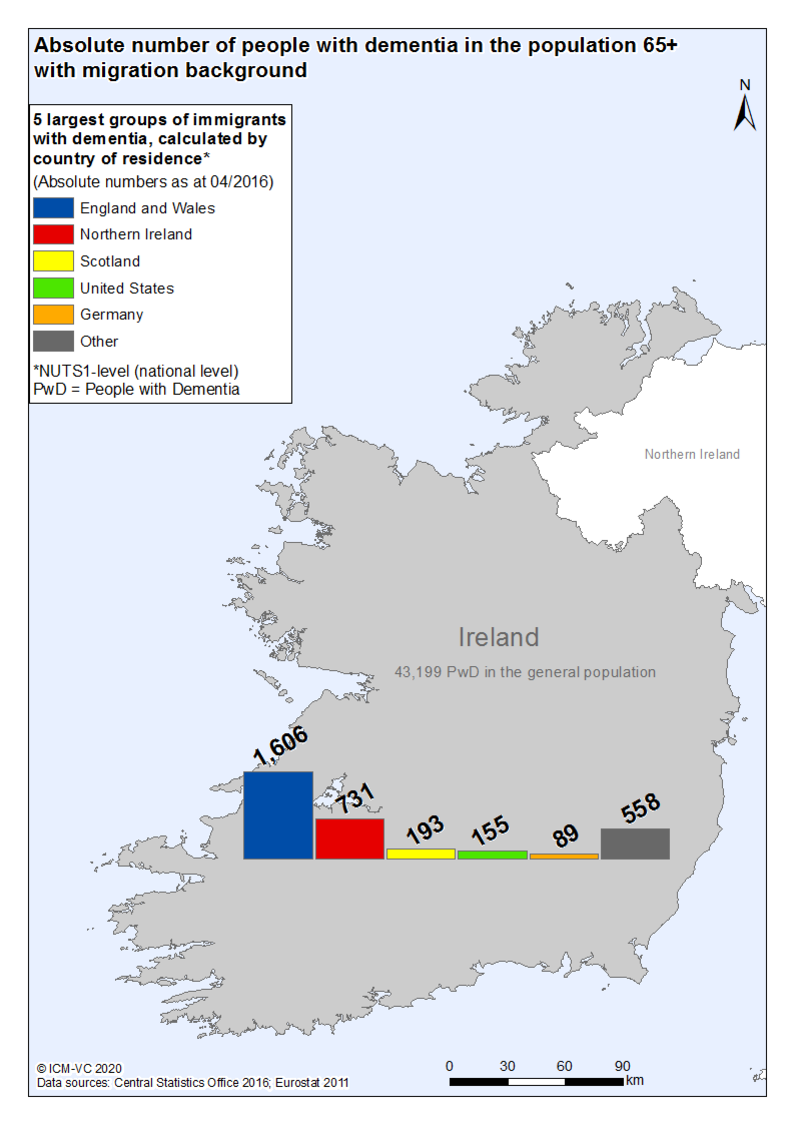EU-Atlas: Dementia & Migration
| Largest group | 2. largest group | 3. largest group | 4. largest group | 5. largest group | |
| Absolute numbers | |||||
| PwMD per 100,000 inhabitants 65+ |
| Absolute numbers | PwMD per 100,000 inhabitants 65+ | |
| Largest group | ||
| 2. largest group | ||
| 3. largest group | ||
| 4. largest group | ||
| 5. largest group |
| Prevalence per 100,000 inhabitants 65+*, calculated by country of residence | |||
|---|---|---|---|
| high > PwMD |
minor > - PwMD |
||
| increased > - PwMD |
low ≤ PwMD | ||
| medium > - PwMD |
|||
| PwMD = People with a Migration background with Dementia *Bulgarien, Litauen, Malta, Polen in der Bevölkerung 60+ |
|||
| Absolute number of PwMD 65+ | |
| PwMD per 100,000 inhabitants 65+ |
Ireland
Ireland is traditionally a country of emigration. Since 1800, about ten million people have left the country1. In the 1990s, Ireland developed into a country of immigration. The economic growth led to the return of many Irish emigrants from the mid-1990s to the early 2000s2. At the same time, the number of asylum seekers increased significantly3. After the EU enlargement in 2004, a large number of people came from the ten new member states2. In 2013, people from Great Britain and Northern Ireland (253,600), Poland (124,600), Lithuania (37,800), the US (24,900), and Latvia (21,800) represented the largest migrant groups4. Between 1990 and 2019, the migrant population (born abroad) has grown from 228,000 to 833,6005.
There are 48,300 people with a migration background aged 65 or older. Of those, approx. 3,300 are estimated to exhibit some form of dementia. Calculations show the most affected migrant groups presumably originate from England and Wales (approx. 1,600), Northern Ireland (approx. 700), Scotland (approx. 200), the US (approx. 200), and Germany (approx. 100)6.
For Ireland, a national dementia strategy (published in 2014) and a guide on ‘Dementia: Diagnosis & Management in General Practice’ (from 2019) could be identified. While the dementia strategy does not consider migration7 the dementia guide briefly references this topic at three points in a subchapter. First, it identifies the problem that a person's cultural background may influence their performance in cognitive impairment screening tools. Then the suitability of existing screening tools for cognitive impairment among ethnic minorities is examined. The MIS and the Mini-Cog Screening Test are two tools that are described as particularly suitable for ethnic minorities8.
According to an interviewed expert, the healthcare system does not treat people with a migration background with dementia as a vulnerable group. There are no specialised services for this population and no information on dementia in different languages. The expert declares that existing dementia services are not suitable for people with and without a migration background.
According to the expert, training on culturally sensitive care does not seem to be offered as part of healthcare providers education. However, sometimes in courses related to the end of life, topics such as being mindfulness of somebody’s religion are covered, although this is not widely done. The expert assumed that the proportion of people with a migration background among professional caregivers working in outpatient and inpatient care is very high.
The expert rated the importance of family, religious communities, migrant organisations, and service providers of outpatient and inpatient care as sources of support for family caregivers as high to very high. Particularly, the expert stressed the importance of supporting families through information and education.
References
- Glynn I, Kelly T, Piaras MÉ: The Re-emergence of Emigration from Ireland. In. Washington, DC: Migration Policy Institute; 2015.
- Quinn E: Country Profile Ireland. In. Edited by Hamburgisches WeltWirtschaftsInstitut, Bundeszentrale für politische Bildung, vol. 19; 2010.
- Éinrí PM, White A: Immigration into the Republic of Ireland: a bibliography of recent research. Irish Geography 2008, 41(2):151-179.
- United Nations: Migration Profiles: Ireland; 2013.
- International Organisation for Migration: Total number of international migrants at mid-year 2019: Ireland; 2019.
- Central Statistics Office: Census 2016. In. Cork: Central Statistics Office 2016.
- Department of Health: The Irish National Dementia Strategy. In. Dublin; 2014.
- Foley T, Jennings A, Swanwick G: Dementia: Diagnosis & Management in General Practice: ICGP Quality and Safety in Practice Committee; 2019.



![[Translate to Englisch:] Logo RBS [Translate to Englisch:] Logo RBS](/fileadmin/_processed_/9/7/csm_RBS_Logo_RGB_0e245a98a4.jpeg)